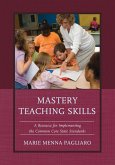30,95 €
30,95 €
inkl. MwSt.
Sofort per Download lieferbar

15 °P sammeln
30,95 €
Als Download kaufen

30,95 €
inkl. MwSt.
Sofort per Download lieferbar

15 °P sammeln
Jetzt verschenken
Alle Infos zum eBook verschenken
30,95 €
inkl. MwSt.
Sofort per Download lieferbar
Alle Infos zum eBook verschenken

15 °P sammeln
- Format: PDF
- Merkliste
- Auf die Merkliste
- Bewerten Bewerten
- Teilen
- Produkt teilen
- Produkterinnerung
- Produkterinnerung

Bitte loggen Sie sich zunächst in Ihr Kundenkonto ein oder registrieren Sie sich bei
bücher.de, um das eBook-Abo tolino select nutzen zu können.
Hier können Sie sich einloggen
Hier können Sie sich einloggen
Sie sind bereits eingeloggt. Klicken Sie auf 2. tolino select Abo, um fortzufahren.

Bitte loggen Sie sich zunächst in Ihr Kundenkonto ein oder registrieren Sie sich bei bücher.de, um das eBook-Abo tolino select nutzen zu können.
Curriculum at Your Core is a practical guide to designing curriculum that meets standards, serves personal and institutional values, and intentionally leads to successful student learning. Identifying which understandings, knowledge, and skills are "most important" for students to learn is always a question of values, so getting clear on values gives teachers a starting place to design cohesive units, courses, and programs. Written by a teacher for teachers, Curriculum at Your Core includes stories, examples, and case studies from across grade levels and subjects, as well as exercises,…mehr
- Geräte: PC
- mit Kopierschutz
- eBook Hilfe
- Größe: 4.6MB
Andere Kunden interessierten sich auch für
![Brainstorming Common Core (eBook, PDF) Brainstorming Common Core (eBook, PDF)]() Eldon "Cap" LeeBrainstorming Common Core (eBook, PDF)31,95 €
Eldon "Cap" LeeBrainstorming Common Core (eBook, PDF)31,95 €![Self-Regulation and the Common Core (eBook, PDF) Self-Regulation and the Common Core (eBook, PDF)]() Marie C. WhiteSelf-Regulation and the Common Core (eBook, PDF)29,95 €
Marie C. WhiteSelf-Regulation and the Common Core (eBook, PDF)29,95 €![What's in Your CORE? (eBook, PDF) What's in Your CORE? (eBook, PDF)]() Gary GoelzWhat's in Your CORE? (eBook, PDF)22,95 €
Gary GoelzWhat's in Your CORE? (eBook, PDF)22,95 €![The Misdirection of Education Policy (eBook, PDF) The Misdirection of Education Policy (eBook, PDF)]() Nancy DafoeThe Misdirection of Education Policy (eBook, PDF)22,95 €
Nancy DafoeThe Misdirection of Education Policy (eBook, PDF)22,95 €![The Game Plan (eBook, PDF) The Game Plan (eBook, PDF)]() Daron W. KennettThe Game Plan (eBook, PDF)43,95 €
Daron W. KennettThe Game Plan (eBook, PDF)43,95 €![The Wrong Direction for Today's Schools (eBook, PDF) The Wrong Direction for Today's Schools (eBook, PDF)]() Ernest J. Zarra IIIThe Wrong Direction for Today's Schools (eBook, PDF)43,95 €
Ernest J. Zarra IIIThe Wrong Direction for Today's Schools (eBook, PDF)43,95 €![Mastery Teaching Skills (eBook, PDF) Mastery Teaching Skills (eBook, PDF)]() Marie Menna PagliaroMastery Teaching Skills (eBook, PDF)24,95 €
Marie Menna PagliaroMastery Teaching Skills (eBook, PDF)24,95 €-
-
-
Curriculum at Your Core is a practical guide to designing curriculum that meets standards, serves personal and institutional values, and intentionally leads to successful student learning. Identifying which understandings, knowledge, and skills are "most important" for students to learn is always a question of values, so getting clear on values gives teachers a starting place to design cohesive units, courses, and programs. Written by a teacher for teachers, Curriculum at Your Core includes stories, examples, and case studies from across grade levels and subjects, as well as exercises, protocols, and templates teachers can use when writing values-congruent curriculum. Some key features include: stories of failures and successes in designing curriculummetaphors from everyday life to help teachers understand curriculum design as a process rooted in values and culminating in meaningful learningexamples of essential questions, assessment guidelines, lesson calendars, unit plans, and curriculum mapsexercises and templates teachers can use to create and assess curriculumprotocols designed to encourage inclusive participation and critical reflection when colleagues look at curriculum together
Produktdetails
- Produktdetails
- Verlag: Bloomsbury eBooks US
- Seitenzahl: 139
- Erscheinungstermin: 8. Oktober 2014
- Englisch
- ISBN-13: 9798216308140
- Artikelnr.: 74844878
- Verlag: Bloomsbury eBooks US
- Seitenzahl: 139
- Erscheinungstermin: 8. Oktober 2014
- Englisch
- ISBN-13: 9798216308140
- Artikelnr.: 74844878
- Herstellerkennzeichnung Die Herstellerinformationen sind derzeit nicht verfügbar.
Lauren Porosoff has been an educator since 2000, and she writes and presents about how to design curriculum and professional development that empowers students and teachers. Informed by research and practices from contextual behavioral science, her work also includes the books EMPOWER Your Students and Two-for-One Teaching, and more than 30 articles about how students and teachers can clarify and commit to their values at school.
Curriculum at Your Core: Meaningful Teaching in the Age of Standards
Preface: The Values That Guided This Book
Acknowledgments: The Evolution of a Values-Congruent Book
Introduction: Why Values?
Curriculum That Serves Multiple Sets of ValuesA Place at the Table: Your
Values and the StandardsUsing This BookChapter 1: Clarifying the Values
that Guide Your Teaching
Why Values?What Values Are (and Aren't)A Place at the Table: Your Values
and the StandardsClarifying Your Values as a TeacherMaking Values
StatementsRendering Values from Academic DocumentsAvoiding Your
ValuesBarriers to Teaching By Your ValuesGetting Stuck in Self-Limiting
BeliefsAvoiding Uncomfortable FeelingsDisregarding What Matters
MostExternal FactorsJust NoticingChapter 2: Designing Curriculum Using
Multiple Sets of Values
Teachers' Values vs. Students' ValuesLearning What Your Students
ValueTeachers' Values vs. Other Teachers' ValuesValues Clarification for
GroupsTeachers' Values vs. Institutional ValuesWorking with Institutional
ValuesAccounting for Multiple Sets of ValuesChapter 3: Using Values to
Focus Units
The Unity of a UnitRingmasters and DroversMaking Titles MatterEssential or
Valued?What Essential Questions Sound LikeFrom Values to Essential
QuestionsChapter 4: Organizing Lessons in a Values-Congruent Unit
GatheringChoosing What to Include -- and What to Let GoBeginning a Unit
with What's FamiliarIntroducing New MaterialChoosing Instructional
MethodsCreating Meaningful Contexts for Student WorkProjectsCycles of
Instruction, Practice, and ApplicationRegularly Returning to What
MattersUsing the CalendarMaking a Lesson CalendarMaking AdjustmentsChapter
5: Values-Congruent Assessments
Kinds of Assessment Tasks"Values-Dense" AssessmentsStudents Choosing How
They're AssessedWhen and How Often to Give AssessmentsHelping Students
Reach Outcomes You ValueProvide Multiple Models of Excellent Work for
Students to AnalyzeTeach All the Skills Students Need to Do WellAllow Class
Time for Students to Reach Your Expected Level of QualityModify Assignments
to Fit Students' NeedsWriting Assignment GuidelinesConsider What to Define
and What to Leave Open-EndedSet Yourself Up to Give Values-Congruent
GradesCopy Valued Expectations from Assignment to AssignmentLook for the
Impact of Unintended BiasProject-Based Assessments and ValuesAdjusting Some
MoreChapter 6: Aligning a Unit
A Values-Aligned UnitResistance to AlignmentGetting AlignedCommon Problems
in Aligning a UnitProblem: When the Lessons and Assessment Don't Match the
Essential QuestionProblem: When the Teacher Values Knowledge or Skills but
Doesn't Explicitly Teach ThemProblem: When the Assessment Task Measures
What's Easy to Measure Instead of the Valued UnderstandingsProblem: When
Teachers Assume Students Will Construct Valued Understandings for
ThemselvesProblem: When the Essential Question Seems So Important That the
Unit Goes On Too LongAssessing Your UnitChapter 7: Designing a
Values-Congruent Course
Courses as HeapsOngoing StrandsCourse-Level Essential QuestionsDesigning a
Meaningful Assessment MixMore Factors in Creating an Assessment
MixMediaGroup SizeLocationsStakesCharting an Assessment MixSequencing Your
CourseCreating Balance Between Competing ValuesBuilding On Students'
Existing Knowledge and Skill SetsCreating a Progression of IdeasUpcycling
Student WorkThinking Flexibly About SequenceAssessing Your CourseChapter 8:
Optimizing Your Students' Experience
Gaps in the CurriculumMaking a Values Map of a ProgramRepetitions in the
CurriculumOptimizing the CurriculumProgrammatic Assessment MixesRemoving
Barriers to Optimizing the CurriculumValues ConflictsIntegrating Diverse
ValuesWriting Programmatic Essential QuestionsMapping Values in the
ProgramSeeking Multiple Valued PracticesChapter 9: Connecting Disciplines
Using Values
Finding ConnectionsWhen Good Cross-Disciplinary Efforts Go
BadCross-Disciplinary Essential QuestionsUsing Cross-Disciplinary Essential
QuestionsOverly Broad Essential QuestionsTwo Kinds of Cross-Disciplinary
UnitsOrganizing a Multi-Class UnitBegin with a Shared ExperienceCreate a
Multi-Class ProjectRefer Frequently to the Essential QuestionMake an
Adjustable Unit CalendarMulti-Class AssessmentsGetting Colleagues
InterestedOvercoming Logistical BarriersGoing for ItChapter 10: Increasing
Values Congruence Over Time
The Evolution of a Values-Congruent UnitUnintended ConsequencesShifting
PrioritiesChanging TimesAction ResearchCritical Friends
GroupsValues-Congruent Professional DevelopmentSetting
GoalsSpecificMeaningfulActiveRealisticTime-LimitedThe Teacher You Want to
BeBibliography
Index
Preface: The Values That Guided This Book
Acknowledgments: The Evolution of a Values-Congruent Book
Introduction: Why Values?
Curriculum That Serves Multiple Sets of ValuesA Place at the Table: Your
Values and the StandardsUsing This BookChapter 1: Clarifying the Values
that Guide Your Teaching
Why Values?What Values Are (and Aren't)A Place at the Table: Your Values
and the StandardsClarifying Your Values as a TeacherMaking Values
StatementsRendering Values from Academic DocumentsAvoiding Your
ValuesBarriers to Teaching By Your ValuesGetting Stuck in Self-Limiting
BeliefsAvoiding Uncomfortable FeelingsDisregarding What Matters
MostExternal FactorsJust NoticingChapter 2: Designing Curriculum Using
Multiple Sets of Values
Teachers' Values vs. Students' ValuesLearning What Your Students
ValueTeachers' Values vs. Other Teachers' ValuesValues Clarification for
GroupsTeachers' Values vs. Institutional ValuesWorking with Institutional
ValuesAccounting for Multiple Sets of ValuesChapter 3: Using Values to
Focus Units
The Unity of a UnitRingmasters and DroversMaking Titles MatterEssential or
Valued?What Essential Questions Sound LikeFrom Values to Essential
QuestionsChapter 4: Organizing Lessons in a Values-Congruent Unit
GatheringChoosing What to Include -- and What to Let GoBeginning a Unit
with What's FamiliarIntroducing New MaterialChoosing Instructional
MethodsCreating Meaningful Contexts for Student WorkProjectsCycles of
Instruction, Practice, and ApplicationRegularly Returning to What
MattersUsing the CalendarMaking a Lesson CalendarMaking AdjustmentsChapter
5: Values-Congruent Assessments
Kinds of Assessment Tasks"Values-Dense" AssessmentsStudents Choosing How
They're AssessedWhen and How Often to Give AssessmentsHelping Students
Reach Outcomes You ValueProvide Multiple Models of Excellent Work for
Students to AnalyzeTeach All the Skills Students Need to Do WellAllow Class
Time for Students to Reach Your Expected Level of QualityModify Assignments
to Fit Students' NeedsWriting Assignment GuidelinesConsider What to Define
and What to Leave Open-EndedSet Yourself Up to Give Values-Congruent
GradesCopy Valued Expectations from Assignment to AssignmentLook for the
Impact of Unintended BiasProject-Based Assessments and ValuesAdjusting Some
MoreChapter 6: Aligning a Unit
A Values-Aligned UnitResistance to AlignmentGetting AlignedCommon Problems
in Aligning a UnitProblem: When the Lessons and Assessment Don't Match the
Essential QuestionProblem: When the Teacher Values Knowledge or Skills but
Doesn't Explicitly Teach ThemProblem: When the Assessment Task Measures
What's Easy to Measure Instead of the Valued UnderstandingsProblem: When
Teachers Assume Students Will Construct Valued Understandings for
ThemselvesProblem: When the Essential Question Seems So Important That the
Unit Goes On Too LongAssessing Your UnitChapter 7: Designing a
Values-Congruent Course
Courses as HeapsOngoing StrandsCourse-Level Essential QuestionsDesigning a
Meaningful Assessment MixMore Factors in Creating an Assessment
MixMediaGroup SizeLocationsStakesCharting an Assessment MixSequencing Your
CourseCreating Balance Between Competing ValuesBuilding On Students'
Existing Knowledge and Skill SetsCreating a Progression of IdeasUpcycling
Student WorkThinking Flexibly About SequenceAssessing Your CourseChapter 8:
Optimizing Your Students' Experience
Gaps in the CurriculumMaking a Values Map of a ProgramRepetitions in the
CurriculumOptimizing the CurriculumProgrammatic Assessment MixesRemoving
Barriers to Optimizing the CurriculumValues ConflictsIntegrating Diverse
ValuesWriting Programmatic Essential QuestionsMapping Values in the
ProgramSeeking Multiple Valued PracticesChapter 9: Connecting Disciplines
Using Values
Finding ConnectionsWhen Good Cross-Disciplinary Efforts Go
BadCross-Disciplinary Essential QuestionsUsing Cross-Disciplinary Essential
QuestionsOverly Broad Essential QuestionsTwo Kinds of Cross-Disciplinary
UnitsOrganizing a Multi-Class UnitBegin with a Shared ExperienceCreate a
Multi-Class ProjectRefer Frequently to the Essential QuestionMake an
Adjustable Unit CalendarMulti-Class AssessmentsGetting Colleagues
InterestedOvercoming Logistical BarriersGoing for ItChapter 10: Increasing
Values Congruence Over Time
The Evolution of a Values-Congruent UnitUnintended ConsequencesShifting
PrioritiesChanging TimesAction ResearchCritical Friends
GroupsValues-Congruent Professional DevelopmentSetting
GoalsSpecificMeaningfulActiveRealisticTime-LimitedThe Teacher You Want to
BeBibliography
Index
Curriculum at Your Core: Meaningful Teaching in the Age of Standards
Preface: The Values That Guided This Book
Acknowledgments: The Evolution of a Values-Congruent Book
Introduction: Why Values?
Curriculum That Serves Multiple Sets of ValuesA Place at the Table: Your
Values and the StandardsUsing This BookChapter 1: Clarifying the Values
that Guide Your Teaching
Why Values?What Values Are (and Aren't)A Place at the Table: Your Values
and the StandardsClarifying Your Values as a TeacherMaking Values
StatementsRendering Values from Academic DocumentsAvoiding Your
ValuesBarriers to Teaching By Your ValuesGetting Stuck in Self-Limiting
BeliefsAvoiding Uncomfortable FeelingsDisregarding What Matters
MostExternal FactorsJust NoticingChapter 2: Designing Curriculum Using
Multiple Sets of Values
Teachers' Values vs. Students' ValuesLearning What Your Students
ValueTeachers' Values vs. Other Teachers' ValuesValues Clarification for
GroupsTeachers' Values vs. Institutional ValuesWorking with Institutional
ValuesAccounting for Multiple Sets of ValuesChapter 3: Using Values to
Focus Units
The Unity of a UnitRingmasters and DroversMaking Titles MatterEssential or
Valued?What Essential Questions Sound LikeFrom Values to Essential
QuestionsChapter 4: Organizing Lessons in a Values-Congruent Unit
GatheringChoosing What to Include -- and What to Let GoBeginning a Unit
with What's FamiliarIntroducing New MaterialChoosing Instructional
MethodsCreating Meaningful Contexts for Student WorkProjectsCycles of
Instruction, Practice, and ApplicationRegularly Returning to What
MattersUsing the CalendarMaking a Lesson CalendarMaking AdjustmentsChapter
5: Values-Congruent Assessments
Kinds of Assessment Tasks"Values-Dense" AssessmentsStudents Choosing How
They're AssessedWhen and How Often to Give AssessmentsHelping Students
Reach Outcomes You ValueProvide Multiple Models of Excellent Work for
Students to AnalyzeTeach All the Skills Students Need to Do WellAllow Class
Time for Students to Reach Your Expected Level of QualityModify Assignments
to Fit Students' NeedsWriting Assignment GuidelinesConsider What to Define
and What to Leave Open-EndedSet Yourself Up to Give Values-Congruent
GradesCopy Valued Expectations from Assignment to AssignmentLook for the
Impact of Unintended BiasProject-Based Assessments and ValuesAdjusting Some
MoreChapter 6: Aligning a Unit
A Values-Aligned UnitResistance to AlignmentGetting AlignedCommon Problems
in Aligning a UnitProblem: When the Lessons and Assessment Don't Match the
Essential QuestionProblem: When the Teacher Values Knowledge or Skills but
Doesn't Explicitly Teach ThemProblem: When the Assessment Task Measures
What's Easy to Measure Instead of the Valued UnderstandingsProblem: When
Teachers Assume Students Will Construct Valued Understandings for
ThemselvesProblem: When the Essential Question Seems So Important That the
Unit Goes On Too LongAssessing Your UnitChapter 7: Designing a
Values-Congruent Course
Courses as HeapsOngoing StrandsCourse-Level Essential QuestionsDesigning a
Meaningful Assessment MixMore Factors in Creating an Assessment
MixMediaGroup SizeLocationsStakesCharting an Assessment MixSequencing Your
CourseCreating Balance Between Competing ValuesBuilding On Students'
Existing Knowledge and Skill SetsCreating a Progression of IdeasUpcycling
Student WorkThinking Flexibly About SequenceAssessing Your CourseChapter 8:
Optimizing Your Students' Experience
Gaps in the CurriculumMaking a Values Map of a ProgramRepetitions in the
CurriculumOptimizing the CurriculumProgrammatic Assessment MixesRemoving
Barriers to Optimizing the CurriculumValues ConflictsIntegrating Diverse
ValuesWriting Programmatic Essential QuestionsMapping Values in the
ProgramSeeking Multiple Valued PracticesChapter 9: Connecting Disciplines
Using Values
Finding ConnectionsWhen Good Cross-Disciplinary Efforts Go
BadCross-Disciplinary Essential QuestionsUsing Cross-Disciplinary Essential
QuestionsOverly Broad Essential QuestionsTwo Kinds of Cross-Disciplinary
UnitsOrganizing a Multi-Class UnitBegin with a Shared ExperienceCreate a
Multi-Class ProjectRefer Frequently to the Essential QuestionMake an
Adjustable Unit CalendarMulti-Class AssessmentsGetting Colleagues
InterestedOvercoming Logistical BarriersGoing for ItChapter 10: Increasing
Values Congruence Over Time
The Evolution of a Values-Congruent UnitUnintended ConsequencesShifting
PrioritiesChanging TimesAction ResearchCritical Friends
GroupsValues-Congruent Professional DevelopmentSetting
GoalsSpecificMeaningfulActiveRealisticTime-LimitedThe Teacher You Want to
BeBibliography
Index
Preface: The Values That Guided This Book
Acknowledgments: The Evolution of a Values-Congruent Book
Introduction: Why Values?
Curriculum That Serves Multiple Sets of ValuesA Place at the Table: Your
Values and the StandardsUsing This BookChapter 1: Clarifying the Values
that Guide Your Teaching
Why Values?What Values Are (and Aren't)A Place at the Table: Your Values
and the StandardsClarifying Your Values as a TeacherMaking Values
StatementsRendering Values from Academic DocumentsAvoiding Your
ValuesBarriers to Teaching By Your ValuesGetting Stuck in Self-Limiting
BeliefsAvoiding Uncomfortable FeelingsDisregarding What Matters
MostExternal FactorsJust NoticingChapter 2: Designing Curriculum Using
Multiple Sets of Values
Teachers' Values vs. Students' ValuesLearning What Your Students
ValueTeachers' Values vs. Other Teachers' ValuesValues Clarification for
GroupsTeachers' Values vs. Institutional ValuesWorking with Institutional
ValuesAccounting for Multiple Sets of ValuesChapter 3: Using Values to
Focus Units
The Unity of a UnitRingmasters and DroversMaking Titles MatterEssential or
Valued?What Essential Questions Sound LikeFrom Values to Essential
QuestionsChapter 4: Organizing Lessons in a Values-Congruent Unit
GatheringChoosing What to Include -- and What to Let GoBeginning a Unit
with What's FamiliarIntroducing New MaterialChoosing Instructional
MethodsCreating Meaningful Contexts for Student WorkProjectsCycles of
Instruction, Practice, and ApplicationRegularly Returning to What
MattersUsing the CalendarMaking a Lesson CalendarMaking AdjustmentsChapter
5: Values-Congruent Assessments
Kinds of Assessment Tasks"Values-Dense" AssessmentsStudents Choosing How
They're AssessedWhen and How Often to Give AssessmentsHelping Students
Reach Outcomes You ValueProvide Multiple Models of Excellent Work for
Students to AnalyzeTeach All the Skills Students Need to Do WellAllow Class
Time for Students to Reach Your Expected Level of QualityModify Assignments
to Fit Students' NeedsWriting Assignment GuidelinesConsider What to Define
and What to Leave Open-EndedSet Yourself Up to Give Values-Congruent
GradesCopy Valued Expectations from Assignment to AssignmentLook for the
Impact of Unintended BiasProject-Based Assessments and ValuesAdjusting Some
MoreChapter 6: Aligning a Unit
A Values-Aligned UnitResistance to AlignmentGetting AlignedCommon Problems
in Aligning a UnitProblem: When the Lessons and Assessment Don't Match the
Essential QuestionProblem: When the Teacher Values Knowledge or Skills but
Doesn't Explicitly Teach ThemProblem: When the Assessment Task Measures
What's Easy to Measure Instead of the Valued UnderstandingsProblem: When
Teachers Assume Students Will Construct Valued Understandings for
ThemselvesProblem: When the Essential Question Seems So Important That the
Unit Goes On Too LongAssessing Your UnitChapter 7: Designing a
Values-Congruent Course
Courses as HeapsOngoing StrandsCourse-Level Essential QuestionsDesigning a
Meaningful Assessment MixMore Factors in Creating an Assessment
MixMediaGroup SizeLocationsStakesCharting an Assessment MixSequencing Your
CourseCreating Balance Between Competing ValuesBuilding On Students'
Existing Knowledge and Skill SetsCreating a Progression of IdeasUpcycling
Student WorkThinking Flexibly About SequenceAssessing Your CourseChapter 8:
Optimizing Your Students' Experience
Gaps in the CurriculumMaking a Values Map of a ProgramRepetitions in the
CurriculumOptimizing the CurriculumProgrammatic Assessment MixesRemoving
Barriers to Optimizing the CurriculumValues ConflictsIntegrating Diverse
ValuesWriting Programmatic Essential QuestionsMapping Values in the
ProgramSeeking Multiple Valued PracticesChapter 9: Connecting Disciplines
Using Values
Finding ConnectionsWhen Good Cross-Disciplinary Efforts Go
BadCross-Disciplinary Essential QuestionsUsing Cross-Disciplinary Essential
QuestionsOverly Broad Essential QuestionsTwo Kinds of Cross-Disciplinary
UnitsOrganizing a Multi-Class UnitBegin with a Shared ExperienceCreate a
Multi-Class ProjectRefer Frequently to the Essential QuestionMake an
Adjustable Unit CalendarMulti-Class AssessmentsGetting Colleagues
InterestedOvercoming Logistical BarriersGoing for ItChapter 10: Increasing
Values Congruence Over Time
The Evolution of a Values-Congruent UnitUnintended ConsequencesShifting
PrioritiesChanging TimesAction ResearchCritical Friends
GroupsValues-Congruent Professional DevelopmentSetting
GoalsSpecificMeaningfulActiveRealisticTime-LimitedThe Teacher You Want to
BeBibliography
Index







